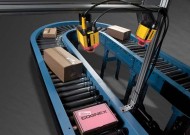 Retail distribution centres require meticulous stock control, which includes careful management of purchasing, shipping and warehouse inventory. Laser systems provide high read rates with good-quality printed barcodes when labels are undamaged, but they have difficulty reading codes under less than ideal conditions. Image-based readers can provide improved read rates, but their cost and complexity have limited their use to high-volume distribution centres… until now. A new generation of image-based readers is poised to revolutionize the market, offering sufficient speed at a price point equal to or lower than that of laser-based alternatives.
Retail distribution centres require meticulous stock control, which includes careful management of purchasing, shipping and warehouse inventory. Laser systems provide high read rates with good-quality printed barcodes when labels are undamaged, but they have difficulty reading codes under less than ideal conditions. Image-based readers can provide improved read rates, but their cost and complexity have limited their use to high-volume distribution centres… until now. A new generation of image-based readers is poised to revolutionize the market, offering sufficient speed at a price point equal to or lower than that of laser-based alternatives.
Image-based barcode reading systems offer several advantages over the laser-based variety. First, because a picture is worth a thousand scans, image-based readers begin with more information about the barcode. This advantage allows them to successfully read codes degraded by damage, orientation or distortion. To compensate for damage to the code or light reflections from the package, the analysis software can reconstruct the data of interest from any legible portion of the image.
Image-based systems can also store images for later retrieval and analysis. Archiving this information helps a distribution facility to determine the root cause for any unread barcodes and implement corrective actions, reducing the number of subsequent misreads and thereby improving process efficiency.
During operation, laser scanners provide no information to help the user determine why a read was unsuccessful. Data from the scanner indicates only the number of packages that were not read successfully, making any attempts to respond reflect pure guesswork rather than data-driven corrective action.
On the other hand, an image-based system can display the scanner image on a monitor or industrial display in real time. As the user sets the system up, the display shows exactly what the scanner sees, ensuring that the images will be in focus and that the image will include all codes on any package that comes down the conveyor. Both initial setup and later adjustments to improve the scanner’s read rate require little specialized knowledge, minimizing setup and maintenance times. And as image-based readers contain no moving parts, this typically results in a useful life that is two to three times longer than that of laser scanners.
Perhaps most important, as large retailers and Internet fulfilment centres consider capital equipment purchases to add capacity or increase throughput, raising barcode read rates by just 1 percent can significantly shorten payback schedules and increase ROI. Capital equipment acquisitions that improve read rates – such as this new generation of high-speed area array image-based readers – enjoy short payback times that can be measured in months, not years. So, the future belongs to the area scan image-based technology.
Cognex




Comments are closed.